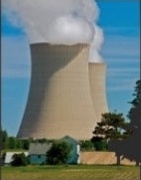By Linda Pentz Gunter
[…]
France is heavily reliant on nuclear energy. Its 56 commercial reactors dot almost every corner of the country, providing 70% of all electricity consumed. France also possesses a nuclear weapons arsenal, fueled by the nuclear power program that predated it.
The possession of nuclear weapons affords France permanent membership status in the UN Security Council — a sense of prestige France is intent on maintaining.
French president, Emmanuel Macron, has now announced that the country will build new nuclear power plants, despite the fact that its current flagship Evolutionary Power Reactor (EPR), is beset by technical mistakes, years behind schedule and billions of Euros over budget at construction sites in France, Finland and the UK. The first of two operational EPRs in China had to be shut down late last year due to vibrations that caused radioactive leakage.
Consequently, it is unpopular to question the use of nuclear power in France and oppositional voices are rarely heard. The French anti-nuclear movement — largely networked under the Réseau Sortir du nucléaire — is snubbed by the press, and its members have been arrested and even convicted of alleged crimes.
However, thanks to the pioneering work of activists, investigative journalists and independent scientists, some of the secrets buried beneath the ’Nuclear Park’, have started to be unearthed.
The damage from uranium mining
Nuclear power plants are fueled with uranium, a radioactive ore that is mined from the earth, typically in dry, desert areas far way, often by an Indigenous workforce offered little to no protection and none of the alleged benefits.
However, between 1948 and 2001, France operated its own uranium mines — more than 250 of them in 27 departments across the country. Those French mine workers, like their Native American, Australian Aboriginal and African Touareg counterparts, labored unprotected and in ignorance of the true health risks.
The mines and the factories that milled and processed the uranium, now lie abandoned, leaving a legacy of radioactive waste that is hidden beneath flowering meadows, forest paths and ornamental lakes. But these radioactive residues and rocks — known as tailings — have also dispersed beyond the old mine boundaries, transported into rivers and streams, absorbed into wild plants, scattered on roadsides, and even paved into children’s playgrounds, homes and parking lots.
There are radioactive hotspots everywhere. France may not yet have opened a high-level radioactive waste repository — still under dispute at Bure — but thanks to the contamination left behind by uranium mining, large swaths of the country are de facto nuclear waste dumps. The widespread dispersal of radioactive contamination across France has been studied extensively by the independent French radiological laboratory, Commission de Recherche et d’Information Indépendantes sur la RADioactivité, known simply as CRIIRAD. Its scientists have traveled all over the world, measuring radiation levels at such notorious nuclear accident sites as Mayak and Chernobyl in the former Soviet Union, and at Fukushima in Japan. But often, they are just as shocked and outraged at the radiation levels they measure at home, and the failure of those responsible to take effective remediation steps to protect the public.
In the 2009 investigative French television program by Pieces de Conviction — entitled Uranium, the scandal of contaminated France — CRIIRAD’s scientific director, physicist Bruno Chareyron, is seen scraping the gravely surface off a parking lot at a cross-country ski club. Under the dusty gray stones we suddenly see a gleam of yellow. It is the telltale sign of uranium and Chareyron’s Geiger counter is recording radiation levels at more than 23mSv an hour. The internationally accepted “safe” dose for the public is 1mSv a year. The public should not have access to this, he says, especially not children who are prone to pick up and pocket pebbles.
In all, there are an estimated 200-300 million tonnes of radioactive tailings dumped across France, exposing those who live, work or play nearby. The contamination comes not only from the uranium, but from its often far more radioactive decay products. And while the state-owned nuclear company Orano (formerly Areva and, before that, Cogema) insists that these sites have been “returned to nature”, it is a purely cosmetic exercise that has granted impunity to the polluter but endangered countless lives.
In 2021, CRIIRAD’s Chareyron returned to the old Bellezane uranium mine, situated in Limousin, the most radioactively contaminated region in all of France. The lab had first taken readings there in 1998. While being filmed for a France 3 Nouvelle-Aquitaine news segment, and standing on a country path accessible to the public, Chareyron recorded radiation readings 10 times higher than what is considered normal for Limousin.
[…]
Operating reactors and childhood leukemia
The electricity generation phase, on which the nuclear lobby bases its low-carbon argument to justify its continued use — while ignoring the front and back ends of the fuel chain, which have significant carbon footprints, (1) — is not without its damage to the environment either. Nuclear reactors release radiation into the environment as part of routine operation. At least 60 epidemiological studies have examined the possible health impacts of these releases, most of which found an increase in rates of leukemia among children living near operating nuclear power plants, compared to those living further away.
The most famous of these studies, conducted in Germany — Case-control study on childhood cancer in the vicinity of nuclear power plants in Germany 1980-2003 (2) — found a 60% increase in all cancers and a 120% increase in leukemias among children living within 5 km of all German nuclear power stations. This study was followed by others, largely supporting the data. But critics speculated that the amount of radioactivity in the releases was too low to have caused these epidemics.
For example, a 2008 study (3) by Laurier et al., of childhood leukemia around French reactors, concluded there was no “excess risk of leukaemia in young children living near French nuclear power plants”. However, the Laurier study was among those rebutted (4) and incorporated into a meta-analysis by Dr. Ian Fairlie and Dr. Alfred Körblein, which concluded that there were statistically significant increases in childhood leukemias near all the nuclear power plants studied and that “the matter is now beyond question, i.e., there’s a very clear association between increased child leukemias and proximity to nuclear power plants.”
The practice of averaging a month’s worth of releases into daily dose amounts ignores a sudden spike in radioactive releases, as happens when a reactor is refueling. Fairlie hypothesizes (5) that these spikes, delivering substantial radiation doses, could result in babies being born pre-leukemic due to exposure in utero, with the potential to progress to full leukemia additionally aggravated by subsequent post-natal exposure. (Nuclear power plants typically refuel every 18 months.)
Radioactive waste — the unsolved problem
At the end of nuclear power operations lies the huge and unsolved radioactive waste problem. Inevitably, the French reliance on nuclear power has generated an enormous amount of radioactive waste that must be managed and, ideally, isolated from the environment.
France is one of the few countries in the world to have chosen reprocessing as a way to try to manage irradiated reactor fuel. Reprocessing involves a chemical separation of plutonium from the uranium products in reactor fuel rods once they have ceased being used in the reactor. This operation is conducted at the giant La Hague reprocessing facility, on the Cherbourg peninsula, which began operation in 1976.
Reprocessing releases larger volumes of radioactivity — typically by a factor of several thousand— than nuclear power plants. Liquid radioactive discharges from La Hague are released through pipes into the English Channel (La Manche), while radioactive gases are emitted from chimney stacks. The liquid discharges from La Hague have been measured at 17 million times more radioactive than normal sea water. La Hague “legally discharges 33 million liters of radioactive liquid into the sea each year,” Yannick Rousselet of Greenpeace France told Deutsche Welle in a 2020 article. This has contributed, among other issues, to elevated concentrations of carcinogenic carbon-14 in sea life (6).
Concentrations of krypton-85 released at La Hague have been recorded at 90,000 times higher than natural background. La Hague is the largest single emitter of krypton-85 anywhere in the world. (7)
A November 1995 study — Incidence of leukemia in young people around La Hague nuclear waste reprocessing plant: a sensitivity analysis (8) — found elevated rates of leukemia. Yet its lead author, Jean-François Viel, was subsequently viciously attacked in attempts to discredit his findings and reputation, attacks that worsened after the publication of a second paper (9) in January 1997.
[…]
Read more.




